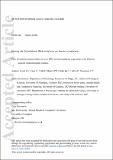Ovarian hormones induce de novo DNA methyltransferase expression in the Siberian hamster suprachiasmatic nucleus
Abstract
Experiments investigated neuroanatomically localized changes in de novo DNA methyltransferase expression in the female Siberian hamster (Phodopus sungorus). The objectives were to identify the neuroendocrine substrates that exhibit rhythmic Dnmt3a and Dnmt3b expression across the oestrous cycle and examine the role of ovarian steroids. Hypothalamic Dnmt3a expression was observed to significantly increase during the transition from proestrous to oestrous. A single bolus injection of diethylstilbestrol (DES) and progesterone was sufficient to increase Dnmt3a cell numbers and Dnmt3b immunoreactive intensity in the suprachiasmatic nucleus (SCN). In vitro analyses using an embryonic rodent cell line revealed that DES was sufficient to induce Dnmt3b expression. Upregulating DNA methylation in vitro reduced expression of vasoactive intestinal polypeptide, Vip, and the circadian clock gene, Bmal1. Together, these data indicate that ovarian steroids drive de novo DNA methyltransferase expression in the mammalian suprachiasmatic nucleus and increased methylation may regulate genes involved in the circadian timing of oestrous: Vip and Bmal1. Overall, epigenetically mediated neuroendocrine reproductive events may reflect an evolutionarily ancient process involved in the timing of female fertility.
Citation
Coyle , C S , Caso , F , Tolla , E , Barrett , P , Onishi , K G , Tello , J A & Stevenson , T J 2020 , ' Ovarian hormones induce de novo DNA methyltransferase expression in the Siberian hamster suprachiasmatic nucleus ' , Journal of Neuroendocrinology , vol. 32 , no. 2 , e12819 . https://doi.org/10.1111/jne.12819
Publication
Journal of Neuroendocrinology
Status
Peer reviewed
ISSN
1365-2826Type
Journal article
Description
TJS thanks the British Society for Neuroendocrinology and the Society for Reproduction and Fertility for research project funds. PB acknowledges the Scottish Government for funding.Collections
Items in the St Andrews Research Repository are protected by copyright, with all rights reserved, unless otherwise indicated.

